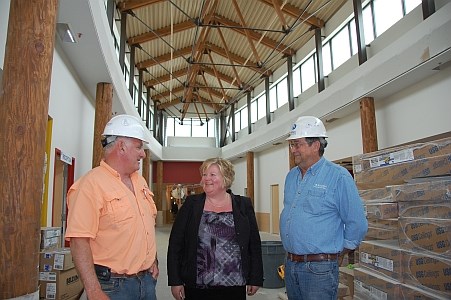Sioux Lookout has always prided itself on being the "Hub of the North."
Economic development officer Florence Bailey doesn’t want to change that moniker. Instead, she wants to find ways to enhance it.
The northwestern Ontario community of 5,300 at the end of twisting Highway 72 has always made its mark as a regional administrative hub for 29 First Nation communities that stretch as far north as James Bay.
With three tribal council offices located in town and a surprisingly busy airport that handles almost 100,000 passengers annually, the municipality has embarked on a 20-year growth plan that’s evident this summer with a flurry of construction activity.
An estimated $200 million in capital projects are underway including the completion of a new hospital this fall, a downtown revitalization project and the development of residential subdivisions.
It’s caused some trepidation among local taxpayers, but for Sioux Lookout, located 70 kilometres off the Trans-Canada Highway, the economic stagnation of the past decade just can’t go on.
“Council’s philosophy is to invest in ourselves in order to have others invest in us,” said Bailey. “What we’ve done in the past obviously isn’t working so we have to do something differently.”
Like many towns in the region, the cyclical forest industry and U.S. tourism have traditionally been huge economic drivers. Luckily, the once-idled McKenzie Forest Products, a Buchanan-owned sawmill in nearby Hudson, is back operating with 65 people after being shut down since October 2008.
Easily the biggest project taking shape is the Meno Ya Win Health Centre, a 63-bed facility scheduled to open in early November.
As the Aboriginal name suggests, the 150,000-square-foot hospital is geared toward handling the medical needs of the remote fly-in communities.
About a third of all patients from the Far North stay in Sioux Lookout.
Carved out of the bush on the town’s north end, the $135-million project includes a 100-bed hostel for families.
The First Nation perspective is noticeable in the building’s design. Heavy spruce timbers form the cathedral-like ceiling of a circular ‘gathering place.’ Resembling a teepee on the outside, the building contains a ceremonial room with a fire pit.
The one-of-kind facility will feature a unique traditional medicine and food program. A designated kitchen area is earmarked for the preparation of moose meat and other wild game.
There will be other patient amenities such as interpreters to translate medical terminology into Oji-Cree.
Hospital contractor Ellis Don is hooking up patient rooms with Skype software to keep Aboriginal families web-connected with their distant communities.
Among the 174-person workforce, there are 29 First Nation people, many who were hired by Ellis Don and their sub-contractors as general labourers.
“We try to hire as many local people as we can,” said Robert Holmes, senior superintendent for EllisDon, of their partnership with the Sioux Lookout Area Aboriginal Management Board. The company even arranges site tours for young people from the Far North. “Hopefully one or two will choose the profession.”
Some quality-of-life construction will be taking place in the town’s core.
At the railyards, Sioux Lookout’s historic train station is getting an image makeover.
Built in 1910 by Canadian National Railway, the station is the centrepiece of a major $8-million revitalization effort on Front Street that includes converting the former Sioux Hotel into a Cultural Centre for Youth and Arts.
The station’s interior was gutted by a private developer before the municipality acquired it four years ago. More restoration work takes place this summer to make way for some incoming commercial and retail tenants.
Adjoining Centennial Park will be redeveloped for a farmer’s market, skateboard park and serve as a festival site.
The Ministry of Natural Resources plans to build a new lakeside fire management centre next year and a new $7-million addition is being added onto the courthouse.
To solve a pent-up demand for housing, two subdivision projects are under development.
Thunder Bay’s Finnway Contracting has cleared land for a 90-lot subdivision that will be a mix of townhouses, apartments, duplexes and triplexes.
The Ministry of Natural Resources has released Crown land in Hudson to the municipality to clear the way for a 90-lot subdivision offering lakefront property.
The town wants a private developer to take charge, said Bailey, “but if there is no interest then the municipality will be the developer.”
New businesses have come to town, including MacDiarmid Lumber and Thunder Bay’s True Grit Consulting, an engineering firm looking to serve First Nation clients.
The town is also investigating the creation of an urban reserve as an investment attraction tool. These reserves are federally designated lands within a municipality where First Nations can establish businesses or lease out.
They can range from light industrial parks, to big box stores, to single-business lots.
Unfortunately, the project is stalled. The town received provincial money for a feasibility study but the federal government has yet to contribute.
The immediate benefit is job creation and skills development, especially for Aboriginals. But as a tax-free zone, there is worry from local businesses that urban reserve retailers can undercut others on pricing on goods.
“It’s a rock we want to turn over and see what’s exposed," said Bailey. "But until we get a commitment from the (federal) level of government, it will remain covered.”




